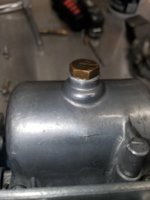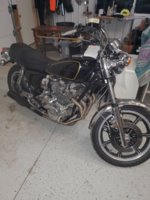Took a look and yes aluminum expands about 15-20% more than brass so heat is a bonus.
https://www.engineeringtoolbox.com/thermal-expansion-metals-d_859.html
If you have the carbs fully stripped a 300 degree oven might be a good thing.
Otherwise a heat gun with some caution.
Here's the mark 1a idea.
View attachment 160923
stiff paper to prevent marring the carb bore
pin about 3/8" proud of the top of the bar so you can see to get it lined up on the screw tip.
hint: to make the pin just the right size, chuck it in a drill then spin while grinding a reduced section at the end.
get the carb body in a vice or such so you have a stable platform. load up the bar with hand pressure then light taps near the end with a small hammer to shock the screw tip loose.
Look up some jetmechmarty posts on XS1100 carbs, there are some gotchas, about carb year vs. jets used.


